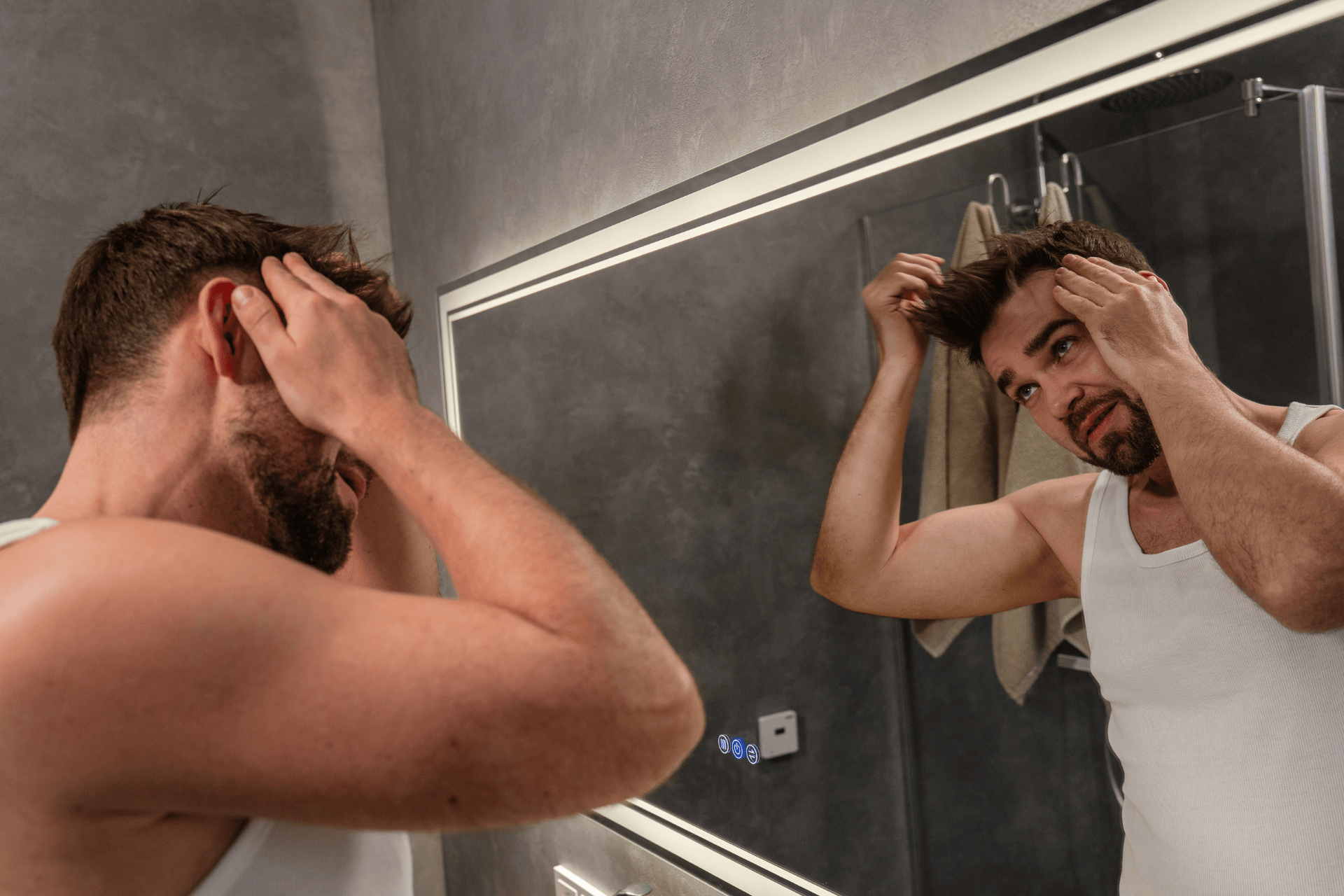Does Testosterone Cause Hair Loss?
Many people wonder if testosterone is the reason behind their thinning hair or bald spots. Hair loss can be frustrating and confusing, especially when you hear different [...]
Read More
Medically reviewed by Abhijit Bhattacharyya | MD, PhD, MBA, Tufts University School of Medicine - Miami, Florida on November 18th, 2025.
Many people wonder if testosterone is the reason behind their thinning hair or bald spots. Hair loss can be frustrating and confusing, especially when you hear different things from friends or online. This article will explain how testosterone relates to hair loss, what really causes it, and what you can do if you notice your hair thinning.
 Understanding Testosterone and Hair Loss
Understanding Testosterone and Hair LossTestosterone is a hormone found in both men and women, but men usually have higher levels. It helps with muscle growth, energy, mood, and many other body functions. It also plays a role in hair growth, but not always in the way people think. In addition to its physical effects, testosterone influences various psychological aspects, including motivation and confidence. This multifaceted hormone is produced primarily in the testes in men and the ovaries in women, with small amounts produced by the adrenal glands in both sexes. The balance of testosterone is crucial for overall health, and fluctuations can lead to a range of issues, from mood disorders to changes in body composition.
Testosterone itself does not directly cause hair loss. Instead, a byproduct of testosterone called dihydrotestosterone (DHT) is the main factor linked to hair thinning and baldness. DHT is made when an enzyme in the body converts testosterone into this stronger hormone. This conversion is particularly significant during puberty and middle age when testosterone levels peak and then gradually decline. The sensitivity of hair follicles to DHT varies among individuals, which is why some people experience hair loss earlier or more severely than others.
DHT binds to hair follicles, especially on the scalp, and can shrink them over time. This shrinking makes hair thinner and shorter until the follicles stop producing hair altogether. This process is called androgenetic alopecia, or male and female pattern baldness. Interestingly, while DHT is often vilified for its role in hair loss, it is also essential for other bodily functions, such as maintaining libido and muscle mass. Understanding the dual nature of DHT can help individuals make informed decisions about treatment options. Various treatments, such as finasteride and minoxidil, aim to block the effects of DHT or stimulate hair growth, providing hope for those affected by hair loss.
Not everyone with high testosterone or DHT levels will lose hair. Genetics determines how sensitive your hair follicles are to DHT. If your close family members have experienced pattern baldness, you are more likely to have it too.
This explains why some men with normal testosterone levels still lose hair, while others with higher levels do not.
Interestingly, the genetic factors influencing hair loss can be traced to multiple genes, not just one. Research has shown that variations in genes associated with androgen receptors can significantly impact how hair follicles respond to DHT. This means that even if you inherit a predisposition for hair loss, the severity and pattern can vary widely among individuals, leading to a diverse range of experiences with thinning hair. Environmental factors and lifestyle choices, such as diet and stress levels, can also interact with these genetic predispositions, further complicating the picture of hair loss susceptibility.
Hair loss often starts in your 20s or 30s, but it can happen at any age. As you get older, hormone levels change, and hair follicles become more sensitive to DHT. This makes hair loss more common with age.
In addition to the natural aging process, certain life events can accelerate hair loss. For instance, hormonal changes associated with pregnancy, menopause, or significant weight fluctuations can all lead to increased hair shedding. Furthermore, chronic stress can elevate cortisol levels, which may indirectly influence hair loss by disrupting the hair growth cycle. Understanding these factors is crucial for those at risk, as it highlights the importance of managing stress and maintaining a balanced lifestyle to potentially mitigate hair loss as they age.
Hair loss is not always about testosterone or DHT. Conditions like thyroid problems, anemia, and autoimmune diseases can cause hair to fall out. Some medications, including those for blood pressure or depression, may also lead to hair thinning.
Stress, poor diet, and lack of sleep can affect hair health. When your body is under stress, it can push hair follicles into a resting phase, causing hair to shed more than usual. This type of hair loss is usually temporary but can be upsetting.
If you are worried about hair loss, the first step is to talk to a healthcare provider. They can test your hormone levels and check for other causes. Telehealth services like Doctronic.ai offer quick and affordable video visits with licensed doctors who can help diagnose and recommend treatment options from the comfort of your home.
Medications: Drugs like finasteride and minoxidil are commonly prescribed to slow hair loss and encourage regrowth. Finasteride works by lowering DHT levels in the scalp.
Hair Care: Gentle hair care routines and avoiding harsh chemicals can protect your hair.
Lifestyle Changes: Eating a balanced diet, managing stress, and getting enough sleep support healthy hair growth.
For personalized advice and treatment, consider using Doctronic.ai to connect with healthcare professionals anytime, anywhere.
Testosterone itself does not cause hair loss. It is the hormone DHT, made from testosterone, that affects hair follicles. Not everyone with high testosterone will lose hair.
Women also produce testosterone and DHT, though in smaller amounts. Female pattern hair loss can also be linked to DHT sensitivity, but it usually looks different from male pattern baldness.
Shaving does not affect the hormones or follicles causing hair loss. It only changes the appearance temporarily.
If you notice sudden or patchy hair loss, scalp irritation, or hair falling out in large amounts, it is important to see a healthcare provider. These could be signs of conditions that need treatment beyond pattern baldness.
Getting a diagnosis and starting treatment is easier than ever with telehealth. Doctronic.ai provides affordable, 24/7 access to doctors who can evaluate your symptoms, order tests, and prescribe medication if needed. This can save time and make managing hair loss less stressful.
 Understanding Hair Loss and Moving Forward
Understanding Hair Loss and Moving ForwardTestosterone is not the villain in hair loss, but its byproduct DHT can play a role in pattern baldness for those genetically sensitive. Knowing the facts helps you make smart choices about your hair health. If hair loss is affecting your confidence or comfort, professional advice is the best next step.
Remember, many people experience hair loss, and there are effective treatments available. Using trusted telehealth services like Doctronic.ai can connect you with expert care quickly and affordably.
Testosterone supplements can increase DHT levels, which may speed up hair loss in people sensitive to DHT. It is important to discuss risks with a doctor before starting supplements.
Some hair loss can be slowed or partially reversed with treatments like minoxidil and finasteride, especially if started early. Results vary by person.
Stress-related hair loss is usually temporary. Once stress is managed, hair often grows back over several months.
Some natural supplements claim to reduce DHT, but evidence is limited. Medical treatments prescribed by a doctor are more reliable.
Telehealth platforms like Doctronic.ai offer fast, affordable video visits with doctors who can assess hair loss and recommend next steps.
Many people wonder if testosterone is the reason behind their thinning hair or bald spots. Hair loss can be frustrating and confusing, especially when you hear different [...]
Read More